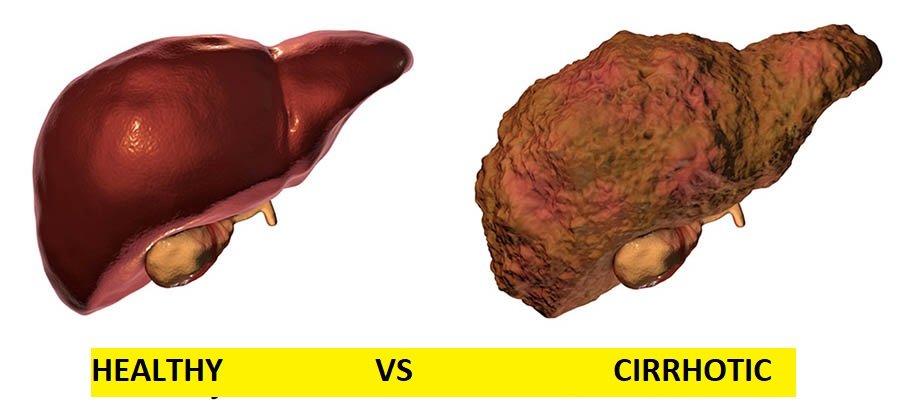A dangerous medical illness called cirrhosis of the liver is typified by the liver tissue’s increasing scarring. Cirrhosis of the liver symptoms are various. This scarring impairs the liver’s regular operation and may result in a number of symptoms and problems.

Understanding the signs and symptoms of cirrhosis is essential for a timely diagnosis and course of treatment. We will go into great length about the signs and symptoms of cirrhosis of the liver, their causes, and the effects they have on the health of the patient in this essay. Cirrhosis of the liver symptoms are various in numbers.
The Liver: An Essential Organ
Prior to discussing cirrhosis symptoms, it is important to comprehend the function of the liver in the body. The liver is an essential organ that performs a variety of tasks that are essential to preserving general health. These include the creation of proteins required for blood coagulation and immune system function, metabolism of nutrition, bile generation for digesting, and detoxification. Cirrhosis of the liver symptoms are various to discuss today.
What Is Cirrhosis of the Liver?
Cirrhosis of the liver occurs when long-term inflammation and damage cause healthy liver tissue to be replaced by scar tissue. The liver’s normal structure and function are disrupted by this scarring. The most frequent causes of cirrhosis are hereditary abnormalities, fatty liver disease, viral hepatitis (e.g., hepatitis B and C), and chronic alcohol misuse. Cirrhosis of the liver symptoms are best for those who are affected by this.
Liver Cleansing Tea- SHOP NOW
 BUY NOW
BUY NOW
Cirrhosis Of The Liver Symptoms
The degree of liver damage and the disease’s stage can have a significant impact on the symptoms of cirrhosis. As the disease advances, some people may have more noticeable symptoms while others may have little or no symptoms at all in the early stages. The following are a few of the most typical signs and symptoms of liver cirrhosis:
1. Fatigue and Weakness
Weakness and weariness are frequently among the first signs of cirrhosis symptoms. Fatigue and sluggishness may result from the body’s inability to generate a sufficient amount of energy when liver function is impaired. Cirrhosis of the liver symptoms includes fatigue.
2. Jaundice
The accumulation of bilirubin, a waste product that the liver constantly breaks down, can result in jaundice, or a yellowing of the skin and eyes. Bilirubin builds up in the bloodstream when the liver is unable to properly metabolize it, giving rise to the distinctive yellow coloring of the skin and eyes. Cirrhosis of the liver symptoms includes jaundice.
3. Abdominal Swelling
As cirrhosis worsens, fluid buildup in the belly may result in pain and swelling there. Increased pressure in the blood arteries surrounding the liver causes ascites, a condition that is frequently accompanied by weight gain and a bloating or full feeling in the abdomen. Cirrhosis of the liver symptoms includes abdominal swelling.
4. Swelling of the Legs and Ankles
Cirrhosis of the liver symptoms includes legs swelling. Some people with cirrhosis may also have edema in their legs and ankles in addition to their abdomen. When fluid builds up in the tissues of the lower limbs as a result of altered blood flow and liver function, the condition is referred to as edema.
5. Easy Bruising and Bleeding
Cirrhosis of the liver symptoms includes bleeding. The liver is an essential organ for the synthesis of the proteins required for blood coagulation. The body may create less clotting factors when liver function is impaired, which makes bleeding and bruises easier to deal with. Even with small traumas, people with cirrhosis may notice an increased propensity to bleed or bruise.
6. Itchy Skin
Pruritus, often known as itchy skin, is a typical indicator of liver illness, particularly cirrhosis. Cirrhosis of the liver symptoms includes skin itching. Although the precise etiology of cirrhosis-related itching is unknown, it is thought to be connected to the accumulation of bile salts in the bloodstream as a result of compromised liver function. Mild to severe skin irritation is possible, and it can be especially uncomfortable at night.
7. Dark Urine and Pale Stools
Individuals suffering from cirrhosis may also see color changes in their urine and stool. Cirrhosis of the liver symptoms includes dark urine. Pale or clay-colored stools may suggest that not enough bile pigment is getting to the intestines, whereas dark urine may be the consequence of too much bilirubin in the urine.
8. Loss of Appetite and Weight Loss
People with advanced cirrhosis may lose their appetite and inadvertently lose weight. Numerous things, such as nausea, discomfort in the abdomen, and modifications in metabolism linked to liver failure, might cause this.
9. Cognitive Changes
Hepatic encephalopathy, a term for cognitive abnormalities that can arise in advanced stages of cirrhosis, is one possibility. These alterations can take many forms, from simple disorientation and forgetfulness to more serious signs including altered personalities, trouble focusing, and in extreme situations, coma.
10. Spider-Like Blood Vessels
People who have cirrhosis may develop spider-like blood veins on their skin, called spider nevi or angiomas. These tiny, red lesions are frequently found on the face, neck, chest, and arms and are brought on by dilated blood vessels.
Complications of Cirrhosis
Apart from the aforementioned symptoms, cirrhosis can result in multiple consequences that worsen the health and well-being of the patient. Among these difficulties are:
- Hepatic encephalopathy: as previously indicated, abnormalities in cognition brought on by liver disease.• Portal hypertension: elevated blood vessel pressure surrounding the liver that can result in consequences like bleeding from the gastrointestinal tract and varices, which are swollen veins.• Liver cancer: people with cirrhosis have a higher chance of getting liver cancer, especially if their cirrhosis is severe and brought on by alcoholic liver disease or viral hepatitis.
• Ascites: a build-up of fluid in the abdominal cavity that may cause complications such as spontaneous bacterial peritonitis and infection.
• Hepatorenal syndrome: kidney failure in patients with severe cirrhosis and ascites is a major consequence.
Conclusion
Liver tissue scarring is the hallmark of the chronic, progressive disease known as cirrhosis of the liver. Understanding the signs and symptoms of cirrhosis is crucial for an early diagnosis and course of treatment to stop more liver damage and consequences. Cirrhosis can cause a wide range of symptoms, but frequent ones include fatigue, jaundice, abdominal swelling, easy bruising, and cognitive abnormalities. For those with cirrhosis, prompt medical diagnosis and care are essential to improve outcomes and quality of life.